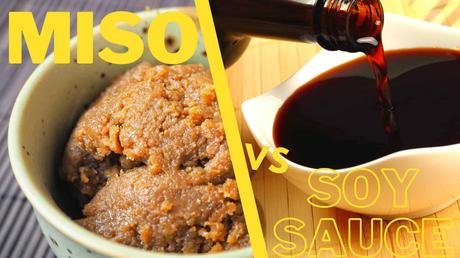As far as seasoning goes, miso and soy sauce are both fine choices.
They are flavorful, widely-found, and go great with a number of dishes.
They are both traditionally made from fermented soybeans mixed with other ingredients.

This ranges from roasted wheat, barley, brine, Aspergillus oryzae, and even seaweed.
In this article, we’ll compare taste, nutrition, and more, providing you with a simple yet useful guide to these popular Asian flavors.
Miso vs Soy Sauce: Taste
Miso is a Japanese seasoning paste, while soy sauce is a liquid condiment of Chinese origin.
Miso is typically salty, but special varieties of miso have also been described as sweet, fruity, and earthy.
Soy sauce is also predominated by a salty flavor, along with a slight sweetness and strong umami flavor.
The umami flavor has a savory and meaty, broth-like taste, and is unique from the other accepted basic tastes (sweet, sour, salty, bitter).
Miso vs Soy Sauce: Uses
Miso is great because it’s versatile.
As well as a seasoning option, it can be served as a main course soup or used to complement your salad dressings and marinades.
You could even stir it in with onions or other vegetables to ramp up the flavor in vegetarian dishes, or alternatively use it as a sauce to serve with fried meat or fish.
While soy sauce is delicious as a sauce, it also makes a great marinade.
You can drizzle it into a stew, or add it to your stir fry.
Dark soy sauce is great for giving some color to noodle dishes.
Alternatively, you could use it as a dipping sauce for dumplings or spring rolls.
Both miso and soy sauce are popular Teppanyaki dipping sauce ingredients!
Miso vs Soy Sauce: Nutrition
Miso is high in important minerals and can be a good source of B vitamins, as well as vitamins E, K, and folic acid.
It is also rich in protein and, as a fermented food, provides beneficial bacteria for the gut.
It does however contain a large amount of salt, and so is not a good option for those who need to limit their salt intake for medical reasons.
Soy sauce is also high in sodium (salt). High intakes of sodium have been linked to increased blood pressure, however, there are sodium-reduced varieties available.
Research has suggested that soy sauce can improve digestion and reduce allergies.
Chemically-produced soy sauce contains toxic substances that can contribute to the risk of cancer.
Naturally-fermented soy sauce is therefore the best option.
However, like all things, miso and soy sauce should be consumed in moderation.
Miso vs Soy Sauce: Cooking Time
The soybean fermentation process for natural miso and soy sauce can take several months.
Before adding either seasoning to your dishes, it is worth considering their burning point.
Miso is traditionally stirred in during the final stage of cooking, either on a low simmer or no heat at all.
Therefore, avoid boiling miso otherwise it’ll lose its flavor and nutritional benefits.
On the other hand, soy sauce is not affected by high heat and can be added at any point during the cooking process.
Miso vs Soy Sauce: Common Dishes
Miso soup is a common dish made from miso.
Miso paste also works well with meat or fish, and common dishes include grilled chicken, salmon, and squid.
It is also customary to mix miso with tofu or eggplant. Similarly, miso combined with vinaigrette creates a well-loved salad dressing.
Soy sauce is commonly used with ramen and rice-based dishes. It goes particularly well with fried rice meals.
Many sesame and vinaigrette salad dressings also use soy sauce.
As a dipping sauce, it is typically served with kimchi fritters, chicken, dumplings, spring rolls, and shrimp.
Miso vs Soy Sauce: Best Brands
On the look-out for great options of both Miso and Soy Sauce?
Miso: Brand Recommendations
There are many options when it comes to buying miso, but here are our recommendations for some top brands.
- Hikari Organic Miso Paste is a must-have for home cooking and is applauded by experts for its accessibility and quality.
- Shirakiku Miso is another brand that offers strong, authentic flavor and affordability.
- Eden Foods Certified Organic Mugi Miso is a good alternative that uses barley instead of rice koji and has a great sweet-savory balance.
- Yutaka Miso Paste is both organic and gluten-free, and another great miso choice.
- Honzokuri Low Salt Miso is low in sodium and perfect for those who want to limit their salt intake.
Soy Sauce: Brand Recommendations
Here are our top picks of soy sauce brands.
- Yamaroku 4 Years Aged Soy Sauce has a rich and mellow flavor and is brewed in Japan with an ancient method that uses kioke wooden barrels.
- Yamasa Soy Sauce is crisp and spicy in aroma with a rich red color, used in many of Japan’s finest restaurants.
- Kimlan Soy Sauce is produced in Taiwan and has a less salty flavor.
- Kishibori Shoyu Soy Sauce has a smooth and balanced taste and is a pure artisan soy sauce.
- Kikkoman Less Salt Soy Sauce uses less salt, making it ideal for those who are after a low-sodium variety.
Find out about this classic Japanese brand: Kikkoman brand origin, products and style
